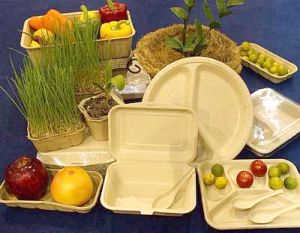Disposal food packaging made of natural fibres such as from oil palm, trees or other plants, should eventually break down when discarded. But often, the wax or plastic coatings used to make these items oil and water-resistant, do not. For chemical engineer Dr Richard Cropp, the solution to this dilemma is a simple one – use a biodegradable film as the coating.
He believes combining this film with fibre-based containers will result in disposal food packaging that will break up instead of fouling the environment. To produce this environment-friendly product, he has teamed up with a packaging manufacturer in Klang, Selangor, which now makes food containers from plant fibre.
 Ecopak food packaging is biodegradable, being made of natural oil palm fibre. Cropp says the biodegradable film is actually collagen extracted from cow skin and processed into a sheer sheet. It is made in Germany and used as sausage casing but Cropp says it works well as a barrier against moisture and grease.
Ecopak food packaging is biodegradable, being made of natural oil palm fibre. Cropp says the biodegradable film is actually collagen extracted from cow skin and processed into a sheer sheet. It is made in Germany and used as sausage casing but Cropp says it works well as a barrier against moisture and grease.
“The film provides an alternative to the plastic or wax coating that are now used in food packaging. It is biodegradable as it is made from natural skin and will be broken up by microbes,” says the German who is married to a Malaysian.
Cropp is familiar with biodegradable products. His company R. Cropp Biofoam Engineering manufactures biodegradable loose fill (those peanut-shaped foam used in packing fragile products). He has applied for a patent on the use of the film on food packaging at the European Patent Office. He is also testing various ways to apply the film, such as by spraying it onto the products or impregnating it inside the pulp.
The applications for the films are numerous but Cropp does not have disposal clamshells in mind. He knows the foolhardiness of competing with the six-sen polystyrene box.
Thus he is thinking more of “value-added” uses in the form of pre-packed convenience food, for instance, cup noodles or microwave meals. This is possible as the film can take temperatures of up to 160°C whereas foamed polystyrene go soft at temperatures above 110°C. He is discussing with a packaging company which now uses plastic bowls.
“Interest in biodegradable packaging is always there but it stops at the price,” he points out.
The biodegradable film retails for 1 euro (RM4.60) a metre, the amount needed to coat the insides of four clamshells. Cropp says with volume, the price can be shaved by 30% to 40% and if the film is produced here, it can drop to 0.15 euro (69 sen) a metre.
Cropp points out that plastic products are cheap only because their real costs are unaccounted for. “The cost of plastic is now only looked at from the price of oil and not the cost of pollution and cleaning up landfills. When you factor in these other costs, plastic is not really that cheap.”
He says with the European Union phasing out foamed polystyrene, the raw material (in the form of preconditioned beads which already contain the blowing agent hexane) is sold cheaply to countries which do not curtail their use, such as Malaysia.
To encourage use of biodegradable packaging, Cropp suggests that the government put a cost to pollution and charge manufacturers a tax for disposing plastic items. The fund is then channelled into research on environment-friendly packaging.
“Plastic waste lying around is like a solidified oil spill. Plastic is acceptable only if it is recycled 100% but since we will not reach that, we must choose the uses for plastic. Coatings can be made from natural materials, so we should not use plastic for them.”
Since greener alternatives exist, some governments have phased out foamed polystyrene. Taiwan is one. In 2002, it banned polystyrene and plastic tableware, first in public facilities and then in private-owned establishments.
It is time for Malaysia to follow suit. Otherwise, we will end up in a sea of white pollution – as the widespread litter of foamed polystyrene is called.
Dr Richard Cropp can be contacted at 03-78472204 or drcropp@gmail.com.
Source
Star Publications (Malaysia) Sept. 06k, 2005.
Share
Renewable Carbon News – Daily Newsletter
Subscribe to our daily email newsletter – the world's leading newsletter on renewable materials and chemicals










